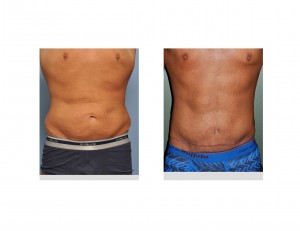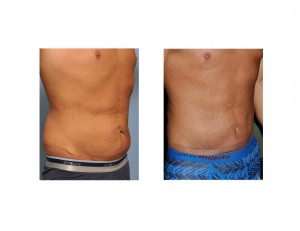Background: Tummy tuck surgery is most frequently thought of as a female procedure. Changes due to pregnancy and weight are the source of the need for improvements in a female’s abdominal and waistline shape. But men do occasionally undergo tummy tuck surgery but pregnancy is obviously not the reason. Weight loss is the exclusive reason in men whether it is due to bariatric surgery or created by diet and exercise alone.
When men lose a lot of weight, they have a better skin retraction than most women. They usually do not have as much loose skin as women due to better elastic properties. The skin is thicker with more elastin fibers and has not been stretched out by the expansile effects of pregnancy. As a result, their abdominal pannuses are much smaller and do not wrap around the waistline as far.
Conceptually a male tummy tuck is no different than in a woman. The excision pattern is marked out based on the excessive and loose abdominal skin and may or may not go above the belly button. But the one key difference is that men do not usually need any muscle tightening through midline fascial plication. They simply do not have a rectus diastasis.
Case Study: This 35 year-old male had lost over 100lbs using diet and exercise alone. He became an avid workout person who lifted weights and ran regularly. He felt that he had done as much as he could on his own but could not get rid the residual loose skin. He now sought a surgical solution.


Many male tummy tucks are very similar to a mini-tummy tuck in women. The tissue excision pattern is somewhat similar and an umbilical repositioning from underneath is also commonly needed. The lack of muscle tightening is the one difference.
Case Highlights:
1) The need for a tummy tuck in a man is almost universally due to a significant amount of weight loss.
2) Extreme amounts of male weight loss result in some loose lower abdominal and waistline skin that often can not be eliminated by diet and exercise alone.
3) The male tummy tuck involves the removal of loose lower abdominal skin but muscle tightening is rarely needed unlike that of a female tummy tuck.
Dr. Barry Eppley
Indianapolis, Indiana


